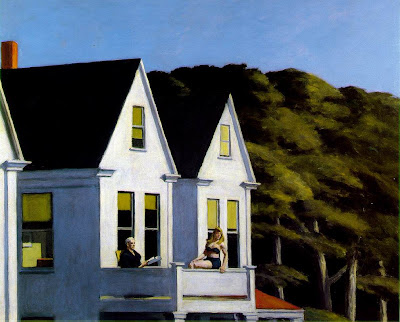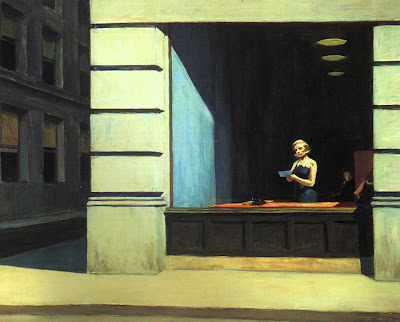Hopper has always been one of my favourite artists, and was an early influence on my own work, since I fell in love with his painting Early Sunday Morning when I stumbled across it (not literally – it was hanging on the wall) in the Whitney Museum, New York, way back in 1969.
Hopper (born Nyack, New York 1882) is the best-known American realist of the inter-war period, once said: 'The man's the work. Something doesn't come out of nothing.' This offers a clue to interpreting the work of an artist who was not only intensely private, but who made solitude and introspection important themes in his painting.
By 1899 he had already decided to become an artist, but his parents persuaded him to begin by studying commercial illustration because this seemed to offer a more secure future. Later, at the New York School of Art, he studied under Robert Henri, one of the fathers of American Realism - a man whom he later described as 'the most influential teacher I had'.
In 1906 he followed the fashion to study in Paris but was later to claim that it had little effect on him - he hadn’t even heard of Picasso while there for instance. He visited Europe on two more occasions – in 1909 and 1910 – then never went to Europe again.
Hopper had settled in Greenwich Village, which was to be his base for the rest of his life, and in 1923 he renewed his friendship with a neighbour, Jo Nivison, whom he had known when they were fellow students under Henri. She was now forty and Hopper fortytwo. In the following year they married. Their long and complex relationship was to be the most important of the artist's life.
From the time of his marriage, Hopper's professional fortunes changed. His second solo show, at the Rehn Gallery in New York in 1924, was a sell-out. The following year, he painted what is now generally acknowledged to be his first fully mature picture, The House by the Railroad. With its deliberate, disciplined spareness, this is typical of what he was to create thereafter.
House by the Railroad 1925
His paintings combine apparently incompatible qualities. Modern in their bleakness and simplicity, they are also full of nostalgia for the puritan virtues of the American past - the kind of quirky nineteenth-century architecture Hopper liked to paint, for instance, could not have been more out of fashion than it was in the mid 1920s, when he first began to look at it seriously.
Once it took off, his career was little affected by the Depression, had become extremely well known. In 1929, he was included in the Museum of Modern Art's second exhibition, Paintings by Nineteen Living Americans, and in 1930 The House by the Railroad entered the museum's permanent collection. In the same year, the Whitney Museum bought Hopper's Early Sunday Morning it's most expensive purchase up to that time. In 1933 Hopper was given a retrospective exhibition at the Museum of Modern Art. This was followed, in 1950, by a fuller retrospective show at the Whitney.
Early Sunday Morning 1930
Some paintings, such as his celebrated image of a gas-station, Gas painted in 1940, even have elements which anticipate Pop Art.
Gas 1940
When the link between the outer world he observed and the inner world of feeling and fantasy broke, Hopper found he was unable to create. In particular, the rise of Abstract Expressionism left him marooned artistically, for he disapproved of many aspects of the new art. He died in 1967, isolated if not forgotten, and Jo Hopper died ten months later. His true importance has only been fully realized in the years since his death. His painting Nighthawks is now one of the most iconic paintings of the C20th.
Nighthawks 1942
Drug Store 1927
Automat 1927
Night Windows 1928
The Lighthouse at Two Lights 1929
New York Movie 1939
Pennsylvania Coal Town 1947
Seven A.M. 1948
Rooms by the Sea 1951
Office in a Small City 1953
Second Story Sunlight 1960
New York Office 1962
Sun in an Empty Room 1963
Chair Car 1965


















No comments:
Post a Comment